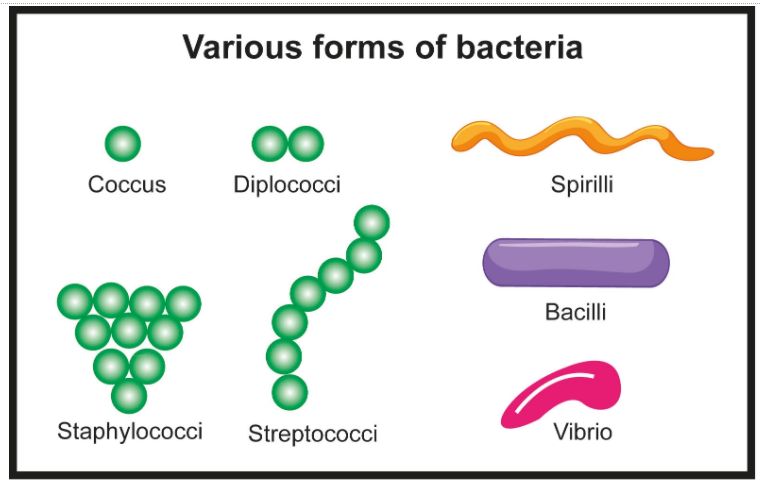
Vibrio are ……….shaped bacteria
Answer
455.4k+ views
Hint: A type of biological cell which constitutes prokaryotic microorganisms are known as bacteria which are few micrometers in length and have numerous shapes. They have different shapes that include rod-shaped or spiral-shaped.
Complete answer:
Vibrio is comma-shaped bacteria. They are also known as rod-shaped bacteria or spiral-shaped cells. They constitute gram-negative bacteria and have different shapes of bacterial cells. They appeared first on earth and are adapted to the soil, water, acid hot springs, radioactive wastes, and deep biosphere of the earth's crust. They show symbiotic and parasitic relationships with certain plants and animals. Bacteria provide necessary genes and enzymes which synthesize cobalamin that is provided through the chain and needed by all animal life for their survival. It synthesizes myelin in the nervous system and constitutes 40 million bacterial cells in a gram of soil and a million bacterial cells in freshwater in the nutrient cycle by decomposition of dead bodies which are responsible for putrefaction which is required in the fixation of nitrogen from the atmosphere. Bacteria provide nutrients that are needed to sustain life in the biological communities surrounded by the hydrothermal vents and cold seats which convert dissolved compounds to energy.
Additional Information: A bacterial cell can grow about 0.5 to 5.0 micrometers in length and few species are visible to the unaided eye. Vibrio bacteria are slightly curved and a small number of other unusual shapes are described such as star-shaped bacteria. Bacterial cell wall and cytoskeleton are important because of their ability to acquire nutrients, attach to the surface, and swim through liquids and escape predators. They often get attached to the surface and form dense aggregations which are known as biofilms and the larger formation are known as microbial mats which can range from a few micrometers to half a meter in thickness and depth respectively and contain multiple species of bacteria.

Note: The human body consists of half of the bacterial cells and the belly button has unique bacterial fingerprints. Bacterias are presently more than three billion years past which is older than a dinosaur. They reproduce quickly through binary fission. Humans were unable to catch the sight of bacteria and till 1674 which was later done by Antoni Van Leeuwenhoek.
Complete answer:
Vibrio is comma-shaped bacteria. They are also known as rod-shaped bacteria or spiral-shaped cells. They constitute gram-negative bacteria and have different shapes of bacterial cells. They appeared first on earth and are adapted to the soil, water, acid hot springs, radioactive wastes, and deep biosphere of the earth's crust. They show symbiotic and parasitic relationships with certain plants and animals. Bacteria provide necessary genes and enzymes which synthesize cobalamin that is provided through the chain and needed by all animal life for their survival. It synthesizes myelin in the nervous system and constitutes 40 million bacterial cells in a gram of soil and a million bacterial cells in freshwater in the nutrient cycle by decomposition of dead bodies which are responsible for putrefaction which is required in the fixation of nitrogen from the atmosphere. Bacteria provide nutrients that are needed to sustain life in the biological communities surrounded by the hydrothermal vents and cold seats which convert dissolved compounds to energy.
Additional Information: A bacterial cell can grow about 0.5 to 5.0 micrometers in length and few species are visible to the unaided eye. Vibrio bacteria are slightly curved and a small number of other unusual shapes are described such as star-shaped bacteria. Bacterial cell wall and cytoskeleton are important because of their ability to acquire nutrients, attach to the surface, and swim through liquids and escape predators. They often get attached to the surface and form dense aggregations which are known as biofilms and the larger formation are known as microbial mats which can range from a few micrometers to half a meter in thickness and depth respectively and contain multiple species of bacteria.

Note: The human body consists of half of the bacterial cells and the belly button has unique bacterial fingerprints. Bacterias are presently more than three billion years past which is older than a dinosaur. They reproduce quickly through binary fission. Humans were unable to catch the sight of bacteria and till 1674 which was later done by Antoni Van Leeuwenhoek.
Recently Updated Pages
Can anyone list 10 advantages and disadvantages of friction

What are the Components of Financial System?

How do you arrange NH4 + BF3 H2O C2H2 in increasing class 11 chemistry CBSE

Is H mCT and q mCT the same thing If so which is more class 11 chemistry CBSE

What are the possible quantum number for the last outermost class 11 chemistry CBSE

Is C2 paramagnetic or diamagnetic class 11 chemistry CBSE

Trending doubts
Which is not a source of freshwater 1 Glaciers and class 11 chemistry CBSE

10 examples of friction in our daily life

The correct order of melting point of 14th group elements class 11 chemistry CBSE

Difference Between Prokaryotic Cells and Eukaryotic Cells

One Metric ton is equal to kg A 10000 B 1000 C 100 class 11 physics CBSE

What is the specific heat capacity of ice water and class 11 physics CBSE




